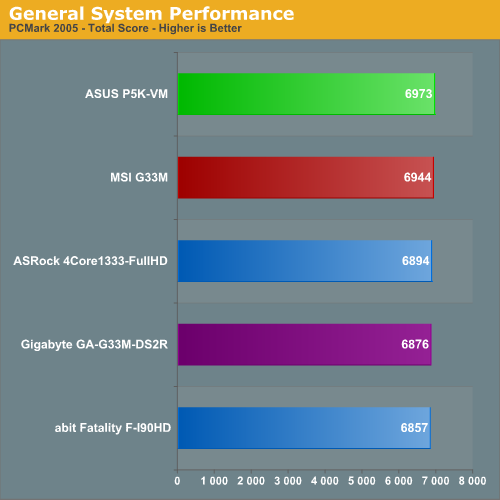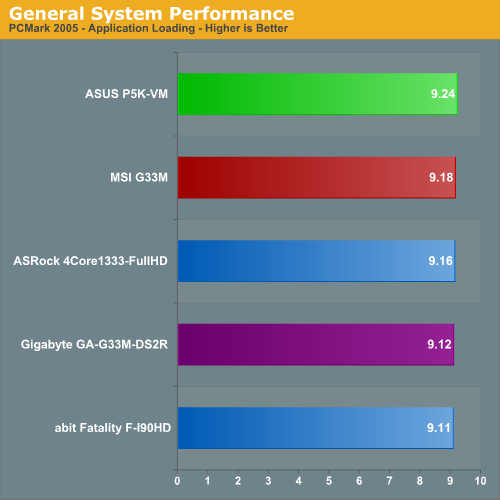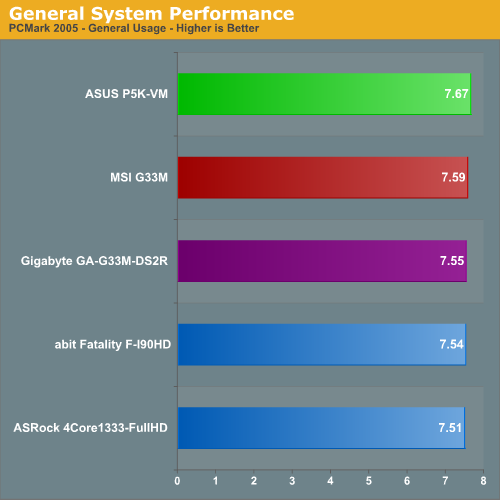µATX Part 2: Intel G33 Performance Review
by Gary Key on September 27, 2007 3:00 AM EST- Posted in
- Motherboards
Disk Controller Performance
We have utilized the Intel iPeak test for the past few years to measure "pure" hard disk or controller performance on Windows XP. Unfortunately, iPeak is not compatible with Vista so we will utilize two sections of the HDD test suite within PCMark05 for comparative hard disk or controller scores. This particular test suite provides a mixture of actual application results and specific read/write percentages within these programs. It is also a readily available benchmark that others can use for comparative purposes. The program utilizes the RankDisk application within the Intel iPeak SPT suite of tools to record a trace of disk activity during usage of real world applications. These traces are then replayed within PCMark05 to generate performance measurements based upon the actual disk operations within each application. The HDD test suite contains 53% read and 47% write operations with each trace section utilizing varied amounts of read or write operations. Additional information about the test suite can be downloaded in PDF format from this location.
The PCMark05 test results we are utilizing are based upon the following trace runs:
Application Loading: This test consists of 83% reading and 17% writes that tracks the opening and closing of the following programs.


The performance pattern in these tests indicates what we witnessed in actual application testing: in tests that are heavily dependent on the storage system, the Intel ICH9 performs the best. The differences are very minor but the ASUS board offers the best overall disk performance among our test units.
We have utilized the Intel iPeak test for the past few years to measure "pure" hard disk or controller performance on Windows XP. Unfortunately, iPeak is not compatible with Vista so we will utilize two sections of the HDD test suite within PCMark05 for comparative hard disk or controller scores. This particular test suite provides a mixture of actual application results and specific read/write percentages within these programs. It is also a readily available benchmark that others can use for comparative purposes. The program utilizes the RankDisk application within the Intel iPeak SPT suite of tools to record a trace of disk activity during usage of real world applications. These traces are then replayed within PCMark05 to generate performance measurements based upon the actual disk operations within each application. The HDD test suite contains 53% read and 47% write operations with each trace section utilizing varied amounts of read or write operations. Additional information about the test suite can be downloaded in PDF format from this location.
The PCMark05 test results we are utilizing are based upon the following trace runs:
Application Loading: This test consists of 83% reading and 17% writes that tracks the opening and closing of the following programs.
- Microsoft Word
- Adobe Acrobat Reader
- Windows Media Player
- 3Dmark 2001SE
- Leadtek WinFast DVD
- Mozilla Internet Browser
- Opening a Microsoft Word document, performing grammar check, saving and closing
- Compression and decompression using WinZip
- Encrypting and decrypting a file using PowerCrypt
- Scanning files for viruses using F-Secure Antivirus
- Playing an MP3 file with Winamp
- Playing a WAV file with Winamp
- Playing a DivX video using the DivX codec and Windows Media Player
- Playing a WMV video file using Windows Media Player
- Viewing pictures using Windows Picture Viewer
- Browsing the Internet using Microsoft Internet Explorer
- Loading, playing and exiting a game with Tom Clancy's Ghost Recon



The performance pattern in these tests indicates what we witnessed in actual application testing: in tests that are heavily dependent on the storage system, the Intel ICH9 performs the best. The differences are very minor but the ASUS board offers the best overall disk performance among our test units.










26 Comments
View All Comments
strikeback03 - Friday, September 28, 2007 - link
When building a couple computers for work using the MSI P35 Platinum board, it appears they don't support eSATA hot-swapping, at least not in XP. I know my Foxconn G965 board at home can do it. Is this behavior still present in the MSI board here? Is it a P35 limitation, or BIOS, or what?hans007 - Friday, September 28, 2007 - link
I dont get it...an svdo card (add2-n) with dvi output costs what $6 on ebay. why dont you guys just buy one, so you can test these with digital.
also the video driver in vista 32bit is not as mature still as the recently released gma 3000 compatible XP driver.
most people actually have XP so could another round of benchmarks in XP be run? I probably wont even get vista for at leas tanother year, since well its pointless and has no reason for being bought at this point.
lopri - Saturday, September 29, 2007 - link
Well.. it seems like you're using Windows XP and a monitor via VGA. Then why bother with these new IGP-based mATX boards? 915G/945G (or GeForce 6100) series would be a better choice for you. They are a lot cheaper (~$50 probably) and XP support is as mature as can be.In the center of this new wave of IGPs is the advent of HD contents. Vista is kinda necessary-evil in a sense but in general it handles HD and multimedia contents a lot better than XP and has a more intuitive/prettier UI for a living room environment. CRT has long been dead in living rooms, and if you prefer CRT over LCD for some reason (professional gaming maybe?) IGP wouldn't be an option to begin with.
I'd say DVI is the minimum requirement, HDMI w/HDCP being a preferred solution in these days and nights.
veritronx - Thursday, September 27, 2007 - link
One thing that may have been overlooked.. The MSI board is the only one suitable for people looking to use a dual-slot graphics card as well as, say, a creative sound card, with some space between them. For that reason the only board reviewed that I would look at buying would be the MSI.Ajax9000 - Thursday, September 27, 2007 - link
From page 1:Read the following Nvidia pages and the news is somewhat disappointing re HD video.
Summary PDF -- http://www.nvidia.com/object/IO_35712.html">http://www.nvidia.com/object/IO_35712.html
AMD (MCP78) features -- http://www.nvidia.com/object/mobo_gpu_features_ben...">http://www.nvidia.com/object/mobo_gpu_features_ben...
AMD (MCP78) specs -- http://www.nvidia.com/object/mobo_gpu_tech_specs.h...">http://www.nvidia.com/object/mobo_gpu_tech_specs.h...
Intel (MCP73) features -- http://www.nvidia.com/object/mcp_features_benefits...">http://www.nvidia.com/object/mcp_features_benefits...
Intel (MCP73) specs -- http://www.nvidia.com/object/mcp_intel_techspecs.h...">http://www.nvidia.com/object/mcp_intel_techspecs.h...
PureVideo is only listed for the MCP78 (7050PV+630a) combination. All the other AMD chipsets and none of the Intel chipsets have PureVideo HD.
If, in the future, they release an MCP73 using (say) 7050PV+630i then memory will be limited to DDR667.
There is no details thus far, but what would be good is if the new chipset fixes the HD Audio problem that all current HDMI video cards seem to suffer from (i.e. the problem whereby the chipset supports HD Audio, but the video cards can only accept SPDIF-grade audio for HDMI pass-through).
BansheeX - Thursday, September 27, 2007 - link
Everyone who is letting these boards have it for not including HDMI/DVI is completely right. It makes no sense. Sure, I could buy a cheap DVI graphics card and stick in there, but if I have to do that, why would I buy a board with onboard graphics in the first place?Sadly missing from this review is the board that DOES include onboard DVI, Intel's own DG33TL. Even sadder is that it takes Intel to make the feature-full board while the OEM companies go for the minimum.
Emma - Thursday, September 27, 2007 - link
I agree with the others, as most computers I build have IGP's, being able to directly compare each of the available IGP's on the market would be about the best thing from a review for a long time.The 6100/6150SE should also be included as this is still widely sold.
Also of interest would be a summary of what other nVidia and AMD IGP's are on the horizon.
Thanks!
Owls - Thursday, September 27, 2007 - link
"We generally feel that users like to install games into the same colored slots for dual channel operation, but MSI chooses to color channel A orange and channel B green."I wasn't aware you could install games into DIMM slots.
JarredWalton - Thursday, September 27, 2007 - link
Sorry 'bout that - I was helping Gary out a bit and managed to mangle the text. Blame the speech recognition. That or I'm just slurring my words a bit. :)8steve8 - Thursday, September 27, 2007 - link
great article tackling most the issues that we care about!question #1: why bother reviewing boards without DVI or HDMI?
whether we are building pc's for friends/offices etc, or an office/server box for ourselves, or we want it to find a home in its post-gaming life when we ditch it for something better... DVI will be key. inexcusable that they pinch pennies there and frankly not worth your time considering these boards. gigabyte has a g33 board with dvi/hdmi, as does intel...
http://www.newegg.com/Product/Product.aspx?Item=N8...">http://www.newegg.com/Product/Product.aspx?Item=N8...
http://www.newegg.com/Product/Product.aspx?Item=N8...">http://www.newegg.com/Product/Product.aspx?Item=N8...
question #2: this would have been muuuch more useful like 5 months ago when G33 was new. now it's about to be eclipsed by the 7150 and g35.
overall i cant wait to see a similar roundup with modern chipsets like g35/nvidia 7150/ g690 and 7050pv for amd...
would be interesting to see a cost/perf of integrated platforms including cpu costs...
mobo + cpu costs... it seems amd has some good cheap 690g boards out there, with dvi/hdmi for around $75. (almost $50 cheaper than a g33 board with dvi)...